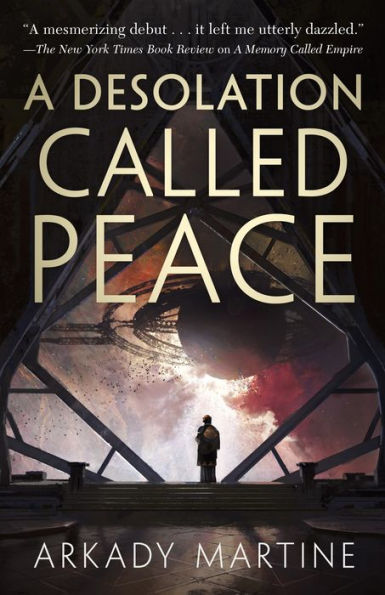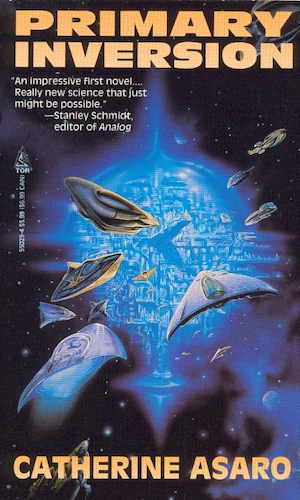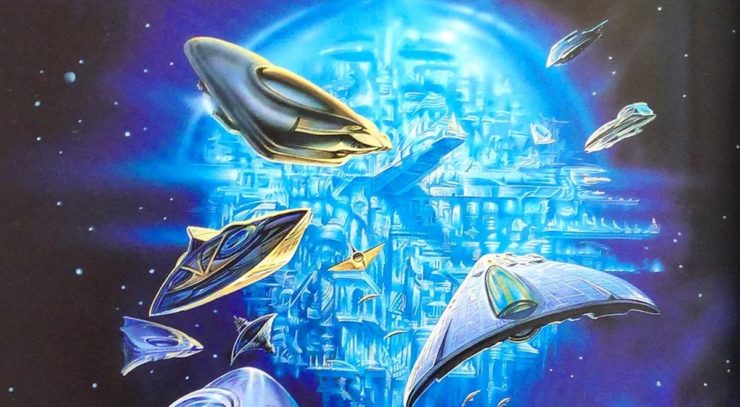In this bi-weekly series reviewing classic science fiction and fantasy books, Alan Brown looks at the front lines and frontiers of the field; books about soldiers and spacers, scientists and engineers, explorers and adventurers. Stories full of what Shakespeare used to refer to as “alarums and excursions”: battles, chases, clashes, and the stuff of excitement.
Primary Inversion, published by Tor Books in 1995, was one of those debut novels that caused the science fiction field to sit up and take notice. It had a little bit of everything: There were star-spanning empires, battling space fighters, technological speculation rooted in cutting-edge science, paranormal powers, romance, drama, and adventure. The headstrong female main character was well realized and appealing. Stanley Schmidt, then editor of Analog, provided a cover blurb that read, “An impressive first novel….Really new science that just might be possible.” The author, Catherine Asaro, showed from the very start that she was going to be a formidable presence in the science fiction community for quite some time.
One of the perils of getting older is that you lose track of time. When I discovered Primary Inversion while reorganizing my basement and saw Catherine Asaro’s name, the first phrase that came to my mind was “promising young author.” Then I stopped for a moment, remembered she written a lot of other books as well, and realized that she has been established for quite some time. In the course of researching this article, I discovered that she is only a few months younger than me (and like I recently did, might well be researching her health care options for when she becomes eligible for Medicare). I don’t feel old (at least not on my better days), but every once in a while, something comes along to remind me that I have indeed been around for quite a while…
About the Author
Catherine Asaro (born in California in 1955) is a writer whose fictional work includes space opera, hard science fiction, and romantic fantasy. She holds a bachelor’s degree in chemistry from UCLA, and a master’s degree in physics and a doctorate in chemical physics from Harvard. She has written a number of scientific papers, including speculations on faster than light travel. She is best known for her Saga of the Skolian Empire, which now includes over 15 novels and many shorter works—some of which have been incorporated into novels, with some standing alone.
Her early career was championed by Stanley Schmidt of Analog magazine, who published Asaro’s tales of the Skolian Empire in novelette and serial formats, along with other pieces of fiction. The latest works in this universe are the Major Bhaajan mysteries, which follow the adventures of a female private investigator who works in a seedy corner of the Skolian Empire called the Undercity. Asaro has been a teacher of math and sciences, a member of a national security advisory think tank, an advocate of STEM education for women, a dancer, musician, singer and songwriter. She served as President of the Science Fiction Writers of America from 2003 to 2005. She is the winner of the Nebula Award for Best Novel, has garnered numerous nominations for both Hugo and Nebula Awards, and received numerous other awards and recognitions within the field. She is a three-time winner of the Analog AnLab award, selected as a favorite by readers of the magazine.
New Space Opera
Buy the Book


A Desolation Called Peace
The sub-genre of space operas has long been a fun corner of the science fiction field. Originally the term was pejorative, much like “soap opera” or “horse opera,” making fun of stories that were focused on adventure rather than science. My ongoing reviews of E. E. “Doc” Smith’s Lensman series focus on a prime example of classic space opera. But many writers have embraced the focus on adventure, and over the years, the quality of writing and increased attention to detail have given the sub-genre more and more credibility.
Critics who argue that the science in space opera tends to serve the story are correct, but that emphasis is not necessarily a bad thing. Space opera often features faster-than-light travel, which allows the action, and the governments and organizations involved in the story, to span many worlds. Often, faster-than-light communication permits coordination of massive fleets. There are nimble spaceships that allow fast-paced combat. There are strange aliens to meet, and strange worlds to explore. Larger-than-life characters give us glimpses into lives that are far more interesting than our own mundane experiences. The universe of space operas is painted in bold, vivid colors, which is part of the fun. The always-useful Encyclopedia of Science Fiction has a general description and exploration of the theme of space opera that you can find here.
A few years ago, Tor.com hosted an event they called Space Opera Week, which presented a number of articles and reviews on the topic. I wrote an article on ten of my favorite space opera universes, which appeared beside an excellent article, written by Judith Tarr, which provided much-needed balance to my admittedly male-oriented list.
The popularity of space operas has waxed and waned over the years, and during the later years of the 20th century the sub-genre gained new popularity. In this column, I have reviewed a number of books by authors who were writing space opera adventures during that period, including Stephen Baxter, Gregory Benford, David Brin, Sharon Lee and Steve Miller, and Vernor Vinge. One of my all-time favorites, Lois McMaster Bujold, has recently been featured in a reread series on Tor.com. There are various other authors from that era who are also worthy of attention, and Catherine Asaro is certainly one of them.
Primary Inversion

The book is divided into three sections, each named for the planet where the action takes place: Delos, Forshires Hold, and Diesha. As this is the first book in a series, there is a lot of backstory and technical detail that needs to be presented to the reader, but Asaro does an excellent job of doling out that information in small doses without bogging down the action.
Delos is a member of the neutral Allied Worlds of Earth, a collection of planets that attempts to remain neutral in a conflict between two competing empires, the Skolian Empire and the Eubian Concord. The Skolians are ruled by a family of powerful telepaths (the Rhon psions) who keep their faster-than-light communications net, the Skol-net, operating. The protagonist, Sauscony Lahaylia Valdoria Skolia, more commonly known as Soz, is a member of that royal family. She is serving as a Jagernaut, part of an elite force of space fighter pilots who are biomechanically enhanced to link directly with their spacecraft and teammates. They are also linked to their Jumblers, nifty disintegrator pistols that use anti-particles to wreak destruction. Soz is on Delos with her teammates, Rex, Helda and Taas, for some rest and relaxation. Rex is especially dear to Soz, and the two of them are considering marriage.
Because it is a neutral world, Delos is also frequented by Eubians, and the team runs into an unusual group of them that includes a strange-seeming Aristo. The Eubians are ruled by the Aristos, an offshoot of Rhon telepaths, whose powers cause them to gain pleasure from the pain of others, people they call “providers.” They are also known as “Traders,” because they traffic in human slaves. I would like to think that a society founded on such unmitigated cruelty could not exist for long, and I have to admit that my repugnance for the Aristos and their practices made the book a difficult read at times. On an undercover mission a few years prior, Soz was captured and abused by an Aristo as she kept her cover intact. On a whim, Soz decides to locate the strange Aristo, storm his rented house single-handedly, figure out why he is different, and free any providers she finds.
She discovers that her target is Jaibriol Qox II, the heir to the Eubian throne, but is not actually an Aristo. Instead, he is a Rhon telepath like her, who can access the Skol-net, and was bred to help his family destroy that net—the biggest advantage the Skolians have in the ongoing war with the Eubians. But his very nature makes him an enemy of his family’s plans. The two of them, without even trying, form an instant and strong bond that only Rhon telepaths can share.
Soz learns the Eubians are about to attack the planet Tams, destroying its atmosphere and committing genocide. She leaves to summon her team to try to save the planet. The space battle that follows is fast paced, and the technology of the space fighters, their propulsion, and their weapons, is rooted in plausible science and presented in a smooth and effective manner. The description of the faster-than-light travel, and the implications of the technology, is especially interesting. The jagernauts are only partially successful in their efforts, and Rex is grievously wounded. This first segment was my favorite part of the novel, full of action and a strong piece of worldbuilding.
Forshires Hold is where Soz’s brother, the Imperator Kurj, sends her after her mission, ostensibly to teach at the local military institute. Rex has broken off their relationship, her family burdens are weighing on her, as are the memories of her torture as an Aristo provider, and the combined impact of her past injuries are a burden Soz can no longer bear. She is suffering from post-traumatic stress. Her duties as an instructor are light, but this only leaves her more time to brood. She tries to meet new people, but proves to be a danger not only to herself but others. She finally breaks down and visits an empathic psychiatrist, a specialist that the jagernauts call a heartbender. She eventually finds a young man she likes and starts a romance, and begins to heal. Soz fights the heartbender at first, but he helps her come to terms with her past, her pain and trauma, and her long-suppressed ambition to succeed her brother on the throne.
Diesha is the site of the military headquarters of the Skolian Empire, and Soz’s brother Kurj has summoned her there. He announces that he has captured the heir to the Eubian throne, Jaibriol Qox II. But he has no idea of Qox’s secret: the fact that he is a Rhon and not an Aristo. Kurj plans to torture Qox for whatever information he can gain, and then announce this political bombshell to discredit the Eubians.
Soz knows the torture will destroy Qox. She has a decision to make. Does she go along with the plan in order to keep her brother happy and her path to the throne intact? Or does she attempt to rescue Qox, who has touched her like no other person ever has? While the first segment focused on war in space, and the second segment centered around a journey of self-discovery, this final segment is a fast-paced thriller, a science fiction tale of star-crossed lovers.
Final Thoughts
Primary Inversion was an impressive debut, and the start of a fine career. Asaro is adept at mixing cutting-edge science, adventure, and romance. The book, with its strong female protagonist, was ahead of its time, and it has held up well over the 25 years since it was published—something you can’t say about a lot of older science fiction. While I was a bit uncomfortable at the sadism portrayed in the book, I can’t think of anything else I would criticize. If you haven’t yet encountered Catherine Asaro’s work, I would recommend it to anyone who enjoys science fiction adventure and space opera.
And now it’s your turn to talk: Have you read Primary Inversion, or the other tales of Skolian Empire? Or any other tales by Catherine Asaro? And what other contemporary writers of space opera do you enjoy?
Alan Brown has been a science fiction fan for over five decades, especially fiction that deals with science, military matters, exploration and adventure.











I know I’ve read at least one of Catherine Asaro’s novels, and it might’ve been this one, or maybe it was The Quantum Rose (that’s the only other title that sounds familiar). I’ve often thought I should track down more of her work, because she helped me out with the science for a story once, way back in 1999 in a conversation on the Analog Forum that existed at the time. (I never sold the story, though.) Like you, I’m startled to realize how long it’s been since then.
I’ve read the first 11 novels in the Skolian series, and Sauscony has always been my favorite character.
I somehow lost track of the series when she switched publishers from Tor to Baen, and later my TBR pile has always been too big to catch up. Maybe I should make another push…
One of my favourite series. So glad you highlighted it. With any luck, Ms Asaro will bring us more Skolian Empire stories.
@2 After I read this book, I was also thinking it was time to revisit the series…
Love this series! In one of my rereads, I read in chronological order according to the timeline instead of publishing date. Time to do another reread, its been a while! Glad you featured it!
Wow, it’s good to see this book being mentioned here. Primary Inversion is my most favorite science fiction book all of times (even more than Dune, and I like Dune) and one of the few books I ever gave 5 stars on Goodreads.
I remember when I first discovered the book – I was browsing Wikipedia for space opera novels and after falling on the article page of the book I read the summary and got interested in the stuff about Jagernauts and empaths so I bought it (imported, I live in Brazil, it took some time to arrive). It was such a find! Amazing mixture of romance, hard science fiction, psychology (I love how Catherine explores PTSD and depression on Soz, best representation of mental illness in a science fiction book I read), action and even a little cyberpunk feel (with the scenes where Soz, a cybernetic soldier, hacks her government’s files directly with her brain).
Also, that cover art is so beautiful (I don’t know which scene of the book it represents though – it looks like the Orbiter, which only appears though in the sequels)
Continue doing more Saga of the Skolian Empire articles, Tor.com. For example, the excellent sequel The Radiant Seas, almost as good as Primary Inversion. The Saga of the Skolian Empire is definitely my most favorite space opera series, even more than the Dune series, the Vorkosigan Saga and the Imperial Radch. I’ll buy and read any Skolian Empire book Catherine releases (Lightning Strike Book II and The Last Hawk are already on my Kindle wishlist), and I wish she would release all her Skolian Empire novels on e-book (the print versions are hard to find).
@3 She is releasing this month a new Major Bhaajan novel, The Vanished Seas. Also recently she re-released e-book versions of her older novels Catch the Lightning (with the new title of Lightning Strike Book I and II) and The Last Hawk.
I read at least six of Catherine Asaro’s books some dozen years ago. I may need to revisit them.
I’ll recommend SK Dunstall’s Linesman series as a recent favorite.
I’ve read all of Asaro’s novels, most with great enjoyment.
The last couple Skolian books are cringy. They read more like self-insert fiction about a singer with the talent to move empires, and at the same time Ms Asaro began thinking that she should start writing and performing songs. Pro-tip: Writing about a good singer doesn’t make you one.
But I heartily recommend books 1-12. Her ideas are fresh and well-integrated into the stories, and she understands how to write both emotionally and technically. I am grateful for the appendices that always explain the physics, because it’s almost always over my head.
I had read several Catherine Asaro books and enjoyed them, but have recently bought all of her books I can find since she appeared as the Hal Clement Science Speaker at a recent Boskone. I’m not rushing through them, but ‘savoring’ them to make them last longer.